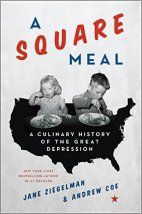A Square Meal: A Culinary History of the Great Depression - Jane Ziegelman & Andy Coe

A Square Meal: A Culinary History of the Great Depression - Jane Ziegelman & Andy Coe
Non-Fiction
Pages: 336
The Great Depression was one of the greatest food crises America has ever faced, a time when farm yields and food output were higher than ever and yet thousands upon thousands of people were starving, a time of 'want amid plenty' as Walter Lippmann famously put it. It was also a time of great change in the world of food production, preparation, storage and nutrition - and the two things are not unconnected.
Prior to the Great Depression most people thought about food much as they had always done - those on farms grew and produced themselves most of what they ate, those in towns and cities bought fresh ingredients produced locally from grocery stores and markets. There was no real means of storing ingredients long-term, so meals were dictated by seasonal availability. Processed or commercially frozen foods were unheard of, canning was mainly for pickles and preserves, and few people had heard of vitamins or calories or had any concept of a 'balanced diet'.
The Great Depression changed all that, largely because the idea of feeding one's family was no longer a matter merely for the woman of the house. Ensuring a healthy population became a matter of state and federal policy at a time when millions of people were unemployed and destitute. When welfare agencies, governmental organisations and charities became by necessity involved in keeping the people fed, the bottom line was always a consideration and diets became a matter of maximum bang for the buck. It was no longer possible for people to eat the way they always had, with nutritional balance being ensured more by accident than design. Menus were rigorously scrutinised and tested, recipes designed to ensure the maximum nutritional benefit for minimal cost, calorie levels calculated for the first time by age, sex, activity levels, the long-term impacts of malnutrition on children beginning to be understood. New technologies were researched and developed to ship food to where it was needed, to store it long-term, to preserve it at its freshest point.
The 1930s was really the era when the modern concept of food began to emerge as we now understand it - freezers and refrigerators, processed food, frozen food, nutritional pyramids, calories and vitamins. It also gave rise to an issue which is still hotly debated today - processed versus fresh, organic versus chemical, slow food versus fast food, regional variety versus homogeneity. Today we are so accustomed to all of these issues that we scarcely think about how they crystallised into issues in the first place.
I would never have thought a book on this topic would have been such interesting reading, and yet I found I could hardly put it down. I've read histories of the Depression before, but never from such a specific angle - and yet to most of those suffering through it the issue of food would have been the most paramount, the central dilemma around which everything else swirled. Homes, jobs, dignity, self-respect, all stemmed from the central inability of parents to feed their children, husbands to keep their families from want and starvation. Food was the issue of the Depression, so it's only right that it should have a history all of its own. I'm only surprised it's taken this long for anyone to write a book from that perspective.